Birla Vidya Niketan in New Delhi follows the curriculum of the Central Board of Secondary Education (CBSE). We adopt a teaching methodology aided with activities and support learners from diverse backgrounds, enabling them to excel in their own ways.
Our goal is to provide an educational experience that stimulates minds, stokes imagination, and broadens the perspectives of pupils. With this in mind, our intradisciplinary online quiz, Friday@8, began as an attempt to engage students during the pandemic, keeping them focused as well as joyful. In the beginning, the quiz included 5 questions on current affairs in which students had 3 minutes to answer.
Currently, it has been extended to 5 domains − General Knowledge, Current Affairs, Science, Numerical Ability, and Logical Reasoning – 20 questions; and 15 minutes of quizzing.
The questions are newspaper, image or video based, not textbook oriented. We don’t allow students to review questions or reattempt in order to help them build their confidence.
The advantages of quizzes
A major positive of this initiative is its timing, 8 o’clock in the evening. Parents are usually around, and they see their children engaging in an intellectually stimulating activity.
Friday@8 is an initiative to track, evaluate, and report learning progress and outcomes. It serves as a self-assessment tool which gives learners freedom to fail. It is a low-stakes quiz and makes learners stop and think, try, make mistakes, and learn from those mistakes. Multimedia and scenarios are used to encourage curiosity and improve learner motivation and commitment.
Imagine you are in a classroom facing a tough but thought-provoking question. You are eager to try, yet face the fear of failure. This situation doesn’t tend to arise in quizzes which are informal. There’s room for everyone to express themselves, test their ideas, and go wrong.
Quizzes can allow learners to figure out what they know, what they don’t, what they need to focus on, and how to improve. Quizzes can provide instant and dynamic feedback to address common misconceptions and errors, reinforce key points, and close knowledge gaps.
The positive impact of Friday@8
Friday@8 challenges learner perceptions and stirs up their interest by asking a question that they are likely to answer wrong. This does not imply posing difficult or unfamiliar questions, but questions which are tricky.
That way, we grab their attention. If you are playing a quiz, no one will criticise a student for getting an answer wrong. Instead, a wrong answer will instil the right answer in their memory.
To help prevent cheating, we have set a time limit based on the complexity which is 20 questions in 15 minutes. Immediate feedback on each answer improves student learning motivation and confidence.
Implementing Friday@8 in your classroom
As a learning strategy, Friday@8 helps cement long-term learning. Why? By retrieving information, students organise it and create cues and connections. Repeated over time, information that is retrieved often becomes more retrievable in the future. This gives students plenty of room for knowledge retention. Here are my key steps for rolling out Friday@ 8 in your school:
Step 1. Define the quiz type – we use a mix of reinforcement and assessment questions. Here are some examples:
Q.1 When one individual imitates another, _______ has occurred.
a. modelling
b. imprinting
c. shaping
d. conditioning
Q.2 Andre was unable to make a paper airplane until he watched his cousin Miriam make a few. Now Andre can fold his own paper airplanes. This is an example of
a. second-order conditioning.
b. observational learning.
c. insight.
d. operant conditioning.
Step 2. Choose the types of quiz questions – we include a combination of multiple choice, true and false, sequencing, matching, and fill in the blanks.
Step 3. Make good questions − the efficacy of our quiz depends on our questions. Poorly worded questions increase the frequency of inaccurate answers. We make precise questions which elicit exact responses and avoid unnecessary hints that allow the learner to deduce the correct answer from the context.
Step 4. Work out answer options − we include good distractors and ensure similar structure and length of answers and distractors.
Step 5. Decide on quiz properties (number of questions, duration, etc) − quiz properties depend on the goal. Our goal is to instil skills and encourage our learners.
Our quiz drives engagement by making learners interact with the content. They have to think, dig deep, and ultimately become an active participant.
During periods of remote learning, what initiatives did you implement to keep students engaged in learning? How have they positively impacted student outcomes? Were you able to continue these initiatives when face-to-face learning resumed? What adaptations did you need to make?



